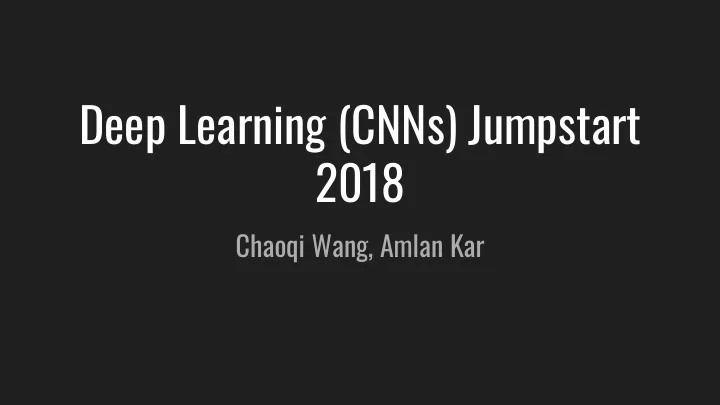

Deep Learning (CNNs) Jumpstart 2018 Chaoqi Wang, Amlan Kar
Why study it?
To the basics and beyond! Note: Buzz will point to recommended resources while we fly through at light speed
Building Blocks We always work with features (represented by real numbers) Each block transforms features to newer features Blocks are designed to exploit implicit regularities
Fully Connected Layer Use all features to compute a new set of features Linear Transformation - F 2 = W T F 1 + b
Non-Linearity Apply a nonlinear function to features Sigmoid (Logistic Function) ReLU (Rectified Linear) Leaky ReLU Exponential Linear (eLU) More: Comprehensive guide to nonlinearities: - Maxout - SeLU https://towardsdatascience.com/secret-sauce-behind-t - Swish he-beauty-of-deep-learning-beginners-guide-to-activati - And so many more ... on-functions-a8e23a57d046
Convolutional Layer Use a small window of features to compute a new set of features Need different parameters? Comprehensive guide to convolutional layers: http://cs231n.github.io/convolutional-networks/
Convolutional Layer Use a small window of features to compute a new set of features - Lesser parameters than a FC layer - Exploits the fact that local features repeat across images - Exploiting implicit order can be seen as a form of model regularization Normal convolution layers look at information in fixed windows. Deformable ConvNets and Non Local Networks propose methods to alleviate this issue
Pooling Aggregate features to form lower dimensional features - Reduce dimensionality of features - Robustness to tiny shifts Max Pooling Average Pooling Also see Global Average Pooling (used in the recent best performing architectures)
Upsampling Layers How to generate more features from less? http://cs231n.stanford.edu/slides/ 2017/cs231n_2017_lecture11.pdf
Upsampling Layers: Subpixel Convolution Produce a grid of nxn features as n^2 filters in a convolution layer https://arxiv.org/pdf/1609.05158.pdf Also read about checkerboard artifacts here: https://distill.pub/2016/deconv-checkerboard/
Upsampling Layers: Transpose Convolution What features did my current features come from? - Convolutions are sparse matrix multiplications - Multiplying the transpose of this matrix to the 4 dimensional input gives a 16 dimensional vector - This is also how backpropagation (used to train networks) works for conv layers! Convolution Matrix Multiplication Do read: http://deeplearning.net/software/theano/tutorial/conv_arithmetic.html#transposed-convolution-arithmetic
Learning Loss Functions Backpropagation
Loss Functions What should our training algorithm optimize? (some common ones) Classification -> Cross Entropy between predicted distribution over classes and ground truth distribution Regression -> L2 Loss, L1 Loss, Huber (smooth-L1) Loss Decision Making (mainly in Reinforcement Learning) -> Expected sum of reward (very often non-differentiable, use many tricks to compute gradients) - Most other tasks have very carefully selected domain specific loss functions and it is one of the most important make it or break it for a network How do we optimize? We use different variants of stochastic gradient descent: w t = w t-1 + a ∇ w http://www.deeplearningbook.org/contents/optimi zation.html - See for more on optimization
w0 x0 w1 Backpropagation x1 sigmoid w2 Chain Rule! 1 1 * -1/(1.37)^2 = -0.53 -0.53 * e^(-1) = -0.20 http://cs231n.github.io/optimization-2/
Task Do it yourself! - Derive the gradients w.r.t. the input and weights for a single fully connected layer - Derive the same for a convolutional layer - Assume that the gradient from the layers above is known and calculate the gradients w.r.t. the weights and activations of this layer. You can do it for any non linearity In case you’re lazy or you want to check your answer: FC - https://medium.com/@erikhallstrm/backpropagation-from-the-beginning-77356edf427d Conv - https://grzegorzgwardys.wordpress.com/2016/04/22/8/
Next Up: A Tour of Star Command’s latest and greatest weapons!
CONV3, FC6, FC7, FC8: Connections with all feature maps in preceding layer, communication across GPUs
Tips for training CNN Know your data, clean your data, and normalize your data. (A common trick: subtract the mean and divide its std.)
Tips for training CNN Augment your data: horizontally flipping, random crops and color jittering.
Tips for training CNN Initialization: a). Calibrating the variances with 1/sqrt(n) w = np.random.randn(n) / sqrt(n) # (mean=0, var=1/n ) This ensures that all neurons have approximately the same output distribution and empirically improves the rate of convergence. (For neural network with ReLUs , w = np.random.randn(n) * sqrt(2.0/n) Is recommended) b). Initializing the bias : Initialize the biases to be zero. For ReLU non-linearities, some people like to use small constant value such as 0.01 for all biases .
Tips for training CNN Initialization: c). Batch Normalization. Less sensitive to initialization
Tips for training CNN Regularization: L1 : for sparsity L2 : penalties peaky weight vectors, and prefers diffuse weight vectors. Dropout: Dropout can be interpreted as sampling a Neural Network within the full Neural Network, and only updating the parameters of the sampled network based on the input data. During testing there is no dropout applied, with the interpretation of evaluating an averaged prediction across the exponentially-sized ensemble of all sub-networks
Tips for training CNN Setting hyperparameters: Learning Rate / Momentum ( Δ wt* = Δ wt + m Δ wt-1) Decrease learning rate while training Setting momentum to 0.8 - 0.9 Batch Size: For large dataset: set to whatever fits your memory For smaller dataset: find a tradeoff between instance randomness and gradient smoothness
Tips for training CNN Monitoring your training (e.g. tensorboard): Optimize your hyperparameter on val and evaluate on test Keep track of training and validation loss during training Do early stopping if training and validation loss diverge Loss doesn’t tell you all. Try precision, class-wise precision, and more
That’s it! You’re now ready for field experience at the deep end of Star Command! Remember: You can only learn while doing it yourself!
Acknowledgements/Other Resources Yukun Zhu’s tutorial from CSC2523 (2015): http://www.cs.toronto.edu/~fidler/teaching/2015/slides/CSC2523/CNN-tutorial.pdf, CS231n CNN Architectures (Stanford): http://cs231n.stanford.edu/slides/2017/cs231n_2017_lecture9.pdf UIUC Advanced Deep Learning Course (2017): http://slazebni.cs.illinois.edu/spring17/lec04_advanced_cnn.pdf
Recommend
More recommend